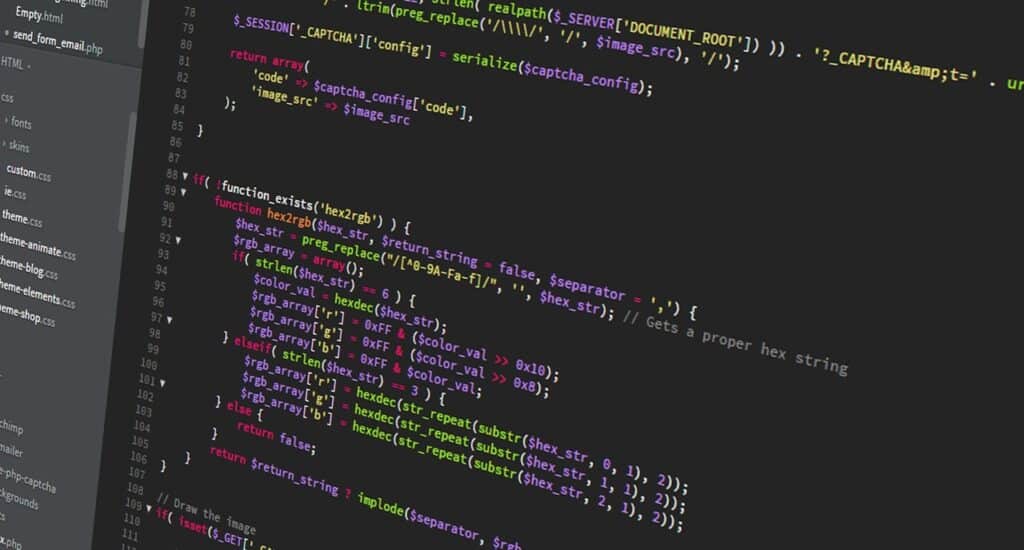Python has become the most popular computer language. Because it supports future-proof technologies such as the Internet of Things, industrial automation solutions, machine learning and AI projects, it will soon become even more important.
Inhaltsverzeichnis
What is Python?
Python is a programming language developed by the Dutch web designer Guido van Rossum and introduced to the market in spring 1991. Currently (as of December 2020), the Version 3.9.1 is offered. The free, universally usable and easily readable language is dynamic and open source. Programmers from all over the world work on it and develop it further. The first complete version of the scripting language named after the comedian Monty Python was published in 1994. van Rossum also wrote a standard library so that Python programmes could be integrated as modules into other computer languages.
Where and in which professions does one apply it?
Many well-known applications such as DropBox, Instagram and YouTube use the Python code. Because it is designed for cross-platform operating systems, the desired programming can be created easily. Therefore, it is suitable for almost everything that needs to be programmed. Even apps for the Android operating system, user interfaces, data analyses and automation solutions can be developed with it. Furthermore, it is used for the following areas:
- the web development
- the web scraping
- the development of new games
- Business applications
- -Artificial Intelligence (AI) projects and machine learning
- statistical purposes (data science)
- CAD applications
Applicability for new websites
For the Creation of new websites with the computer language, one uses well-known frameworks such as Pyramid and libraries. They can be used to integrate protocols such as HTTPS, SSL and FTP and to process e-mails, XML and JSON. The language is also suitable if you want to read huge amounts of data from the internet and use it for specific purposes such as price comparisons (Web Scraping). Among other things, the BeautifulSoup library is used. Developers work with the Python code when they interactive games write. For example, they use a 3-D game engine and functionality-providing libraries such as PyGame. Many popular games such as Civilization IV are based on Python code.
Applicability in the business sector
Applications for the business sector such as shop systems and ERP systems are also based on Python programming. This is because they are easy to read, can be expanded quickly and scaled in no time at all. They are often built on the Tryton platform. Furthermore, Python is excellent for Machine Learning and AI solutions because it already has a large number of libraries. With the help of Python code, machines can learn through stored information or from previous experience. Python-based algorithms help the machine to learn on its own. Artificial intelligence problems can be solved quickly by using the Python libraries and the Algorithm uses.
Applicability in data analysis
Anyone who is professionally involved with the Extraction and analysis of data works with Python libraries such as NumPy and Pandas. Other data collections even allow the information collected to be displayed pictorially, making it easier to create diagrams. Also in the field of Computer-aided design (CAD) the language is indispensable. With the help of Fandango, it enables the simultaneous representation of functions, objects and much more. In addition Media player programme with their help. They are more powerful and stable than other audio and video applications. Professions that commonly work with computer language include:
- Data Analyst
- Data Engineer
- Developer in the field of cloud solutions, finance and accounting
- Engineers in the fields of automotive, mobility service, IoT solutions, IT automation
- Research Manager (Statistics)
- Project engineers (rapid prototyping)
- System administrators
- Bioinformatician
- Data Scientist
- Machine Learning Engineer
What is it not suitable for?
Despite its many advantages, the language also has some weaknesses. These can be seen, for example, in the fact that garbage collection is carried out too slowly. C++ and C work better for this because these languages are better adapted to the hardware.
Is Python easy to learn?
Anyone who does not yet know how to programme and wants to learn should definitely start with Python. Because of its versatility, however, it also offers advanced and professional users many possibilities. Various reasons speak in favour of learning programming better with the Python code: Because it was developed for beginners in programming, its structure (syntax) is very simple. Superfluous code was deliberately omitted. Despite its simplicity, it is in no way inferior to competitors such as C++ and Java: Complex applications can be created with it just as easily as simple plug-ins. In addition, Python beginners find it easier to learn other computer languages later on.
How long does it take to learn Python?
How long each newbie needs to fully master the code depends on various factors. And, of course, on the individual learning speed. Generally speaking, learning the basics is possible in a comparatively short time. However, newbies should be prepared to learn for life.
What prior knowledge and prerequisites does one need for this?
To learn the computer language, you only need knowledge of using a Windows PC and basic mathematical skills. If the course requires prior knowledge of programming, this is indicated in the course description. The Python software runs on all common operating systems. On Linux and OS X it is already available by default.
What are the advantages and disadvantages of Python?
Due to the lean code, the programmes written with it run faster. Installation is quick and uncomplicated. Errors can be removed without much effort. In addition, working with the computer language saves time: less code has to be written to achieve the desired result. In terms of popularity, it has long since overtaken the competition: On developer platforms, it's mostly about Python code. The computer language is also very popular among budding programmers. Because it has a wide range of applications, they have many ideas to copy. If they have questions or problems, a Google search with the appropriate terms often helps.
But there is another reason in favour of the popular programming language: it will become even more important in the future because of its close connection with AI applications. Web and game developers, data analysts and data scientists will use it to an even greater extent for increasingly complex applications. Another advantage is that users have a lot of possibilities with it. For example, they create many smaller programmes that they use in automated processes such as searching websites and saving the data they find. This saves them tedious routine tasks.
The area of automation is one of the greatest strengths of the language, which offers a wide range of plug-ins and modules, frameworks and libraries: In addition to the existing standard library, users have access to more than 125,000 external libraries. Incidentally, they are the reason why the computer language is indispensable in so many IT areas. For users who want to work in the field of machine learning and artificial intelligence, the language offers the ideal basis.
Where and how can you learn Python?
Those who want to learn the computer language have various places and options to choose from. The most convenient, of course, is to take part in a tutorial offered on the Internet. The German-language courses, for which a fee is charged, are put together by Python specialists in such a way that the content is easier to learn. They often offer a detailed introduction. The online tutorial for beginners is available as a video on the home PC and even on the go on the mobile device. It can be paused as needed and replayed at a more convenient time.
Those who do not learn so quickly can repeat the learning material more often in between. In some tutorials, course participants even receive additional learning material. And, as usual with professional courses, a certificate of completion. Complete courses offer a comprehensive introduction to the basics of computer language as well as learning content for advanced learners. With the learning videos, articles, examples from programming practice and the projects to be completed independently, beginners are supposed to master the code after 30 days.
YouTube videos are another way to learn Python programming. However, beginners have to search longer on the platform to find the right online course in German. In contrast to the tutorials offered on the WWW, face-to-face seminars are often only available for expensive money. Fees of more than 1,000 euros per course are not uncommon.
What does a Python code look like?
When writing Python code, a distinction is made between upper and lower case. Indents are obligatory. At the end of the line, the sequence ";" is omitted. Blocks are formed by indenting the lines, not by curly brackets as in C languages. Variables do not have to be declared before their first use. Assignments are formed according to the pattern x = 8. Afterwards, the variable automatically has the value 8. Comparisons are formed analogously to the pattern x == 8.

Conclusion
Those who want to enter the world of programming ideally do so with the Python code. And one of the professional web tutorials. This way, learning succeeds even after a long working day. Due to the rather simple and clear code, even beginners have the possibility to master the computer language in the foreseeable future.











0 Kommentare